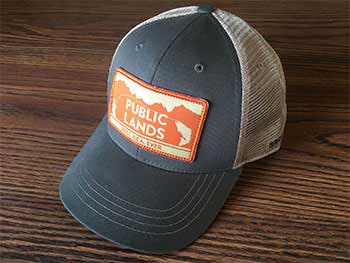Where
The Black River courses through the two million-acre Apache-Sitgreaves National Forests and the San Carlos and Fort Apache reservations in the White Mountains of east-central Arizona. This is not the desert country that Arizona conjures up, but forested terrain criss-crossed with cold, clear-running streams and peaks reaching over 11,000 feet. The Black may be Arizona’s most celebrated trout fishery. In its upper 35 miles – from the confluence of its East and West forks to Paddy Creek – it tumbles through a deep bedrock canyon accented by red rock cliffs and old growth pine. These waters are home to Apache trout, one of the state’s native salmonids
Upper Black River
Why
A chance to cast dry flies for Apache trout in their native range.
“Apache trout were one of the first species listed under the Endangered Species Act, but today they are making comeback,” said Brad Powell, Southwest Region Director for Trout Unlimited. “The Black River is one of the most important watersheds contributing to the recovery.”
Though the world record Apache trout measured 24 inches, most are less than 12 inches—and they’re very opportunistic feeders.
“They are a great fish to catch on dry flies–caddis, Humpies or Parachute Adams,” Powell continued. “The tribs – like the West Fork – are bordered by willows, and demand small stream techniques—shorter, light rods (2- to 4-weight), and short leaders with tippet to 4x or 5x.
You’ll find Apaches in the upper reaches of the forks. Rainbows and brown trout are abundant in the middle and lower sections of the mainstem. As you travel downriver, smallmouth bass become predominant. For me, the Black offers tremendous scenery, abundant wildlife, relief from Arizona’s legendary heat, and great fishing.”
Water conditions are generally best in the summer months.
Apache trout were one of the first species listed under the Endangered Species Act, but today they are making comeback. The Black River is one of the most important watersheds contributing to the recovery.
Brad PowellLocal knowledge
Get appropriate permits.
“Some sections of the Black are on tribal lands and require special permits,” Powell advised. “Also note that some sections of the river are catch and release.”
Support public lands and look good doing it!

TU Initiatives
Much of the Apache Sitgreaves National forest- including most of the Black River Watershed- is within the planning areas of the Four Forest Restoration Area, the nation’s largest forest restoration initiative and the Black River Forest Restoration Project. Trout Unlimited has been working closely with the U.S. Forest Service to ensure that the plan incorporates measures to insure the health of the river and its Apache Trout, including reparation of riparian areas, segregation of non-native species, and new forest management practices that minimize the risk of severely destructive forest fires.
Make a Difference
National Forests like the Apache-Sitgreaves serve as the headwaters for many of our Nation’s watersheds. Please take a moment to express your opposition to EPA’s proposal to rescind the Clean Water Rule and your support for protecting headwater streams. Earlier this year the EPA announced a proposed rule that would rescind the 2015 Clean Water Rule. The 2015 Clean Water Rule did a good job of clarifying and restoring Clean Water Act protections for headwater streams and wetlands.
Please visit standup.tu.org to send a message to the EPA that you oppose its proposal to rescind the 2015 Clean Water Rule and support protecting the Nation’s headwater streams and wetlands.

